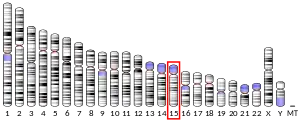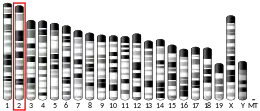KNL1
KNL1 (kinetochore scaffold 1, aka CASC5) is a protein that is encoded by the KNL1 gene in humans.[5][6][7][8]
Function
KNL1 is part of the outer kinetochore. It is a part of KMN network of proteins together with MIS12, and NDC80.[9]
KNL1 is involved in microtubule attachment to chromosome centromeres and in the activation of the spindle checkpoint during mitosis. The CASC5 gene is upregulated in the areas of cell proliferation surrounding the ventricles during fetal brain development.[10]
Polymorphisms
Homozygous polymorphisms in the CASC5 gene have been seen in patients with autosomal recessive primary microcephaly (MCPH). The mutation resulted in the skipping of exon 18 transcription, causing a frameshift and the production of a truncated protein. This truncation inhibits the binding ability of MIS12.[10]
References
- GRCh38: Ensembl release 89: ENSG00000137812 - Ensembl, May 2017
- GRCm38: Ensembl release 89: ENSMUSG00000027326 - Ensembl, May 2017
- "Human PubMed Reference:". National Center for Biotechnology Information, U.S. National Library of Medicine.
- "Mouse PubMed Reference:". National Center for Biotechnology Information, U.S. National Library of Medicine.
- "Entrez Gene: CASC5 cancer susceptibility candidate 5".
- Hayette S, Tigaud I, Vanier A, Martel S, Corbo L, Charrin C, Beillard E, Deleage G, Magaud JP, Rimokh R (September 2000). "AF15q14, a novel partner gene fused to the MLL gene in an acute myeloid leukaemia with a t(11;15)(q23;q14)". Oncogene. 19 (38): 4446–50. doi:10.1038/sj.onc.1203789. PMID 10980622.
- Wei G, Takimoto M, Yoshida I, Mao PZ, Koya RC, Miura T, Kuzumaki N (Jun 2000). "Chromosomal assignment of a novel human gene D40". Nucleic Acids Symposium Series (42): 71–2. PMID 10780384.
- Cheeseman IM, Hori T, Fukagawa T, Desai A (February 2008). "KNL1 and the CENP-H/I/K complex coordinately direct kinetochore assembly in vertebrates". Molecular Biology of the Cell. 19 (2): 587–94. doi:10.1091/mbc.E07-10-1051. PMC 2230600. PMID 18045986.
- D'Archivio S, Wickstead B (February 2017). "Trypanosome outer kinetochore proteins suggest conservation of chromosome segregation machinery across eukaryotes". The Journal of Cell Biology. 216 (2): 379–391. doi:10.1083/jcb.201608043. PMC 5294786. PMID 28034897.
- Genin A, Desir J, Lambert N, Biervliet M, Van Der Aa N, Pierquin G, Killian A, Tosi M, Urbina M, Lefort A, Libert F, Pirson I, Abramowicz M (December 2012). "Kinetochore KMN network gene CASC5 mutated in primary microcephaly". Human Molecular Genetics. 21 (24): 5306–17. doi:10.1093/hmg/dds386. PMID 22983954.
- Cheeseman IM, Niessen S, Anderson S, Hyndman F, Yates JR, Oegema K, Desai A (September 2004). "A conserved protein network controls assembly of the outer kinetochore and its ability to sustain tension". Genes & Development. 18 (18): 2255–68. doi:10.1101/gad.1234104. PMC 517519. PMID 15371340.
- Obuse C, Iwasaki O, Kiyomitsu T, Goshima G, Toyoda Y, Yanagida M (November 2004). "A conserved Mis12 centromere complex is linked to heterochromatic HP1 and outer kinetochore protein Zwint-1". Nature Cell Biology. 6 (11): 1135–41. doi:10.1038/ncb1187. PMID 15502821.
External links
- Human CASC5 genome location and CASC5 gene details page in the UCSC Genome Browser.
Further reading
- Ray ME, Su YA, Meltzer PS, Trent JM (June 1996). "Isolation and characterization of genes associated with chromosome-6 mediated tumor suppression in human malignant melanoma". Oncogene. 12 (12): 2527–33. PMID 8700511.
- Nagase T, Kikuno R, Nakayama M, Hirosawa M, Ohara O (August 2000). "Prediction of the coding sequences of unidentified human genes. XVIII. The complete sequences of 100 new cDNA clones from brain which code for large proteins in vitro". DNA Research. 7 (4): 273–81. doi:10.1093/dnares/7.4.271. PMID 10997877.
- Takimoto M, Wei G, Dosaka-Akita H, Mao P, Kondo S, Sakuragi N, Chiba I, Miura T, Itoh N, Sasao T, Koya RC, Tsukamoto T, Fujimoto S, Katoh H, Kuzumaki N (June 2002). "Frequent expression of new cancer/testis gene D40/AF15q14 in lung cancers of smokers". British Journal of Cancer. 86 (11): 1757–62. doi:10.1038/sj.bjc.6600328. PMC 2375411. PMID 12087463.
- Chinwalla V, Chien A, Odero M, Neilly MB, Zeleznik-Le NJ, Rowley JD (March 2003). "A t(11;15) fuses MLL to two different genes, AF15q14 and a novel gene MPFYVE on chromosome 15". Oncogene. 22 (9): 1400–10. doi:10.1038/sj.onc.1206273. PMID 12618766.
- Kuefer MU, Chinwalla V, Zeleznik-Le NJ, Behm FG, Naeve CW, Rakestraw KM, Mukatira ST, Raimondi SC, Morris SW (March 2003). "Characterization of the MLL partner gene AF15q14 involved in t(11;15)(q23;q14)". Oncogene. 22 (9): 1418–24. doi:10.1038/sj.onc.1206272. PMID 12618768.
- Cheeseman IM, Niessen S, Anderson S, Hyndman F, Yates JR, Oegema K, Desai A (September 2004). "A conserved protein network controls assembly of the outer kinetochore and its ability to sustain tension". Genes & Development. 18 (18): 2255–68. doi:10.1101/gad.1234104. PMC 517519. PMID 15371340.
- Obuse C, Iwasaki O, Kiyomitsu T, Goshima G, Toyoda Y, Yanagida M (November 2004). "A conserved Mis12 centromere complex is linked to heterochromatic HP1 and outer kinetochore protein Zwint-1". Nature Cell Biology. 6 (11): 1135–41. doi:10.1038/ncb1187. PMID 15502821.
- Sasao T, Itoh N, Takano H, Watanabe S, Wei G, Tsukamoto T, Kuzumaki N, Takimoto M (December 2004). "The protein encoded by cancer/testis gene D40/AF15q14 is localized in spermatocytes, acrosomes of spermatids and ejaculated spermatozoa". Reproduction. 128 (6): 709–16. doi:10.1530/rep.1.00312. PMID 15579588.
- Nousiainen M, Silljé HH, Sauer G, Nigg EA, Körner R (April 2006). "Phosphoproteome analysis of the human mitotic spindle". Proceedings of the National Academy of Sciences of the United States of America. 103 (14): 5391–6. Bibcode:2006PNAS..103.5391N. doi:10.1073/pnas.0507066103. PMC 1459365. PMID 16565220.
- Olsen JV, Blagoev B, Gnad F, Macek B, Kumar C, Mortensen P, Mann M (November 2006). "Global, in vivo, and site-specific phosphorylation dynamics in signaling networks". Cell. 127 (3): 635–48. doi:10.1016/j.cell.2006.09.026. PMID 17081983.



